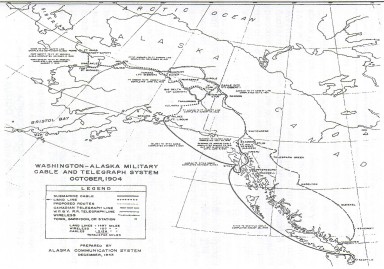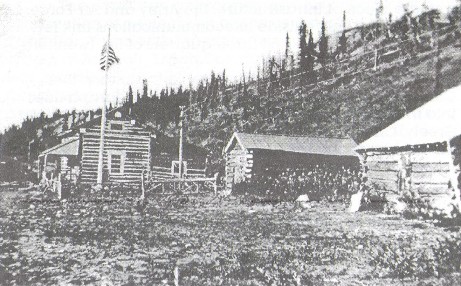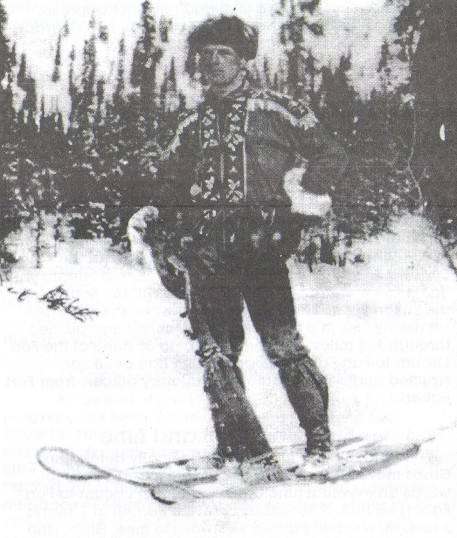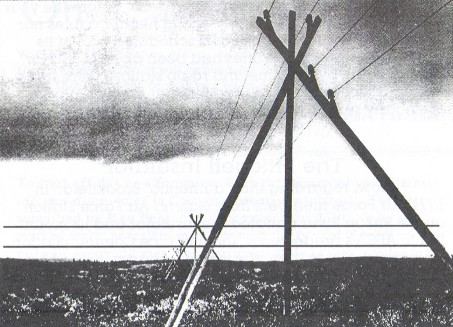A History of the Telegraph In Alaska
by Mark J. Surina
Reprinted from "Crown Jewels of the Wire", July 1998, page 14
In my current assignment at Scott Air Force Base, Illinois, I've had several
opportunities to work with the Air Force Communications Agency (AFCA).
headquartered at this base 25 miles east of St. Louis. My interest was drawn to
the small visitor's center located in the AFCA lobby. There, a variety of
antique Department of Defense communications equipment and memorabilia is
showcased; including one display case with several insulators and a photograph
of a tripod pole. I'm sad to report that the insulators are of the usual
"antique store" run-of-the-mill Hemingray-42 and Ohio Brass genre.
However, one CD 145 aqua W. Brookfield. still on a wooden peg, captured my
interest. It was presented to the AFCA museum as an item off the
Washington-Alaska Military Telegraph and Cable System, the history of which is
described in this article, my condensation of a masters' degree thesis authored
by Mr. Al Moyers. AFCA historian. The authenticity of the Brookfield insulator
was researched by Mr. Moyers before he knew of our hobby -- more on that later.
Billy Mitchell, one of the early proponents of air warfare and an Air Force
separate from its parent, the US Army, was in charge of the construction of part
of this line. Since Mr. Moyers was willing to share his research with us, and
because of the maps which show the route, I felt Crown Jewels of the Wire
readers might be interested in this relatively recent history. I now quote from
Mr. Moyers' thesis, "Wiring the Wilderness: The U.S. Army Signal Corps and
the Construction of the Alaska Communication System, 1900-1936."
- - - - - - - - - - -
Wiring the Wilderness
Technical Sergeant Charles Murphy and his 12-man
construction crew were assigned to begin the construction of a telegraph line
from Valdez. The group arrived in Valdez aboard the SS Excelsior on July 4,
1900.¹ As there was no dock, the ship had to anchor some distance from the shore
and have its load of passengers and cargo ferried to the shore. One adventurous
young man was too anxious to wait. Wishing to get to shore as soon as possible,
he had himself and his three horses lowered into the water to swim to shore. He
tied a rope to his wrist and secured it on the halter of one of the horses in
order to ease his swim to shore. His plan worked fine until the horse reached
the water's end and began running at a gallop up and down the beach dragging its
screaming owner. Murphy's men cornered the horse and cut the young man loose
before he suffered any serious injury. The impatient young man was Jack London,
who had come to Alaska to find the story that would become The Call of the Wild
and would entrench the intrigue of Alaska into the minds of generations to come.²
As the summer construction season of 1900 in Alaska began, the U.S. Army
Signal Corps began construction of the military telegraph lines that would
shortly become known as the Washington-Alaska Military Telegraph and Cable
System, or to most Alaskans, simply WAMCATS. WAMCATS was the life-line of the
territory until 1936 when the complexity and scope of the system would spark the
Army and Congress to rename it the Alaska Communication System (ACS).
¹ Other dates given for the arrival of Murphy and his crew are 30 June 1900
and 8 July 1900. The date, July 4, 1900, is from a 1958 interview with Murphy
for the ACS newspaper TOTEM Telegraph.
² "'The Story of the Alaska Communication System," 18 August 1947, TMs,
pp. 6-8, Box 9, Folder: Anniversary, RG338, National Archives-Alaska Region
(hereafter NA-AK); "WAMCATS," TOTEM Telegraph, July 1958, p. 4, col
2 and p. 11, col. 1, Box 15, Folder: ACS News Bulletins, 1958, 1 of 2, RG342,
NA-AK; Public Information Officer, Alaska Communication System, "Early
History of Alaska Communication System," n.d., pp. 3-4, Box 23, Folder:
Early History of Alaska Communication System, RG342, NA-AK.

Medium Image (102 Kb)
Large Image (254 Kb)
Figure 1. Washington-Alaska Military Cable and
Telegraph System, October,
1904.
(Source: U.S. Air Force Communications Agency Office of History)

Figure 2. WAMCATS Station, Paxson, Alaska.
(Source: U.S. Army Signal Corps
Photo,
U.S. Air Force Communications Agency Office of History)
The story of the Alaska Communication System outlines the continued pattern
of assistance the American government gave frontier settlers. As individuals,
gold rushers could not fight the lawlessness of the mining frontier. They
required the stability that military forts could give them. But military forts
and the communities they support need communication. Alaska's remoteness
outstripped the normal bounds of frontier movement. The federal government could
not induce private industry to build a telegraph line; it was too difficult.
Congress had to produce the line itself. And, so it did. From 1900 to 1936, the
U.S. Army Signal Corps wired the wilderness of Alaska. The Army continued to
operate the system until 1962, when the system was turned over to the U.S. Air
Force which operated it another decade before it was finally sold to RCA-Alaska.
In perhaps the most extreme example of continuous federal funding and operation
of a single piece of infrastructure, the Army and Air Force provided the only
outside telecommunications link for Alaska for nearly the first three-quarters
of the twentieth century.
In the beginning of the twentieth century, the
Canadian government had established telegraph lines into the Yukon. Brigadier
General Adolphus Washington Greely, Chief Signal Officer of the U.S. Army at the
turn of the century, had gained great fame as an Arctic explorer when in the
early 1880s as a young lieutenant he led the Signal Corps' ill-fated expedition
to Canada's Lady Franklin Bay. This fame brought him contacts with many world
leaders. Greely met with his personal friend, Canadian Premier Sir Wilfred
Laurier, to gain permission for Canadian lines to handle Alaskan telegraph
traffic. Laurier approved Greely's proposal and assisted in garnering funding
from the Canadian Parliament for an interconnect between the American line at
Fort Egbert, eleven miles from the Canadian border, and the Canadian telegraph
line at Dawson in the Yukon nearly 121 miles distant.³
Due to the sparsity of
Signal Corps linesmen, the telegraph to the Canadian border from Fort Egbert was
rapidly completed by a detail of 7th Infantrymen under the command of Captain
Charles S. Farnsworth and tied to the Canadian side on May 5, 1901. In little
less than one year after the Congressional action to open Alaska to telegraphic
communications, messages from Fort Egbert were sent to Skagway, Alaska, via
Dawson, Yukon Territory, where they were transferred to steamers bound for
Seattle and tapped into the national telegraph system. A dispatch could now
reach Washington, D.C. from Fort Egbert in four days, a previously unheard of
speed for a message from Alaska. This new communications path cut nearly a month
off the transit time.(4)
³ Congress, House, "Report of the Chief Signal Officer," Annual
Reports of the War Department for the Fiscal Year Ended June 30,1901,
(Washington, D. C.: Government Printing Office, 1901), vol. 2, Reports of Chiefs
of Bureaus, pp. 922-923, 57th Cong., 1st sess., H. Doc. 2 (hereafter
Report of the Chief Signal Officer, 1901).
(4) William Mitchell, General Greely: The Story of a Great American (New York:
G. P. Putnam's Sons, 1936), p. 195; and Congress, House, "Report of the
Chief Signal Officer," Annual Reports of the War Department for the Fiscal
Year Ended June 30,1902 (Washington, D. C.: Government Printing Office, 1903),
vol. 1, Report of the Secretary of War and Reports of Bureau Chiefs, pp.
664-665, 57th Cong., 2d sess., H. Doc. 2 (hereafter Report of the Chief
Signal Officer, 1902).
The Canadian appropriations also called for the construction of a telegraph
line to connect the upper Canadian Yukon with the main Canadian telegraph system
at Ashcroft, British Columbia, This construction was completed on September 24,
1901, and provided direct telegraphic communications between Fort Egbert and
Washington, D,C., or any other point on the world's global telegraphic system.
Federal funding, both U. S, and Canadian ironically, had now truly connected
Alaska to the United States and the world. Now the expanse of Alaska itself had
to be overcome.
Pushing the Line into the Interior
The first major all-Alaskan section of the
military telegraph system, the more than 600 mile wire and cable section from
Fort Davis to Fort Gibbon, was completed on November 18, 1901. For the first
time, the post commanders at the three most westerly garrisons -- Fort Davis, Fort
St. Michael, and Fort Gibbon -- could communicate directly with each other.
The Fort
St. Michael-to-Fort Gibbon leg of the system crossed the barren arctic tundra of
the western coast of Alaska and followed the mighty Yukon River to the center of
the territory. From Unalakleet on the eastern shore of Norton Sound up the
beginnings of the Yukon Valley, twenty-foot iron poles were substituted for the
usual wooden poles. Under normal circumstances the Signal Corps recycled the
cleared timber from the path of the telegraph line into telegraph poles.
Alaska's tundra coastline, however, is devoid of anything remotely resembling a
natural telegraph pole. American iron pole technology had been developed in the
joint telegraphic venture with the British during the China Relief Expedition of
1900 to suppress the Boxer Rebellion.(5)
Placing the iron poles proved a challenge
also. Due to the permafrost in this part of Alaska, the earth's surface is
frozen for a depth of several feet most of the
(5) Office of Technical Liaison, Office of the Chief Signal Officer,
"History and Tradition of the U. S. Army Signal Corps," n.d., TMs, p.
15, Box 4, Folder: Historical Publications, Records of the U. S. Air Force
Commands, Activities, and Organizations, Records of the U. S. Air Force
Communications Service, Records of the Alaska Communication System, 1900-1961,
RG342, NA-AK.
year. The construction crews chipped holes in the frozen ground for the iron
poles and then packed the mud generated from the chipping around the poles to
secure them. Shortly, the poles were as firm as if they had been set in concrete.
(6)
As the telegraph line snaked its way eastward along the north bank of
the Yukon, the terrain over which it passed turned into dense thickets and
forests. The Corpsmen found the going in central Alaska to be as difficult to
penetrate as the jungles of the Philippine Islands, where the Signal Corps had
been employed in telegraph construction since the beginning of the
Spanish-American War. As a Signal Corps historian later summarized the work of
the construction detachments, which averaged 25 to 30 soldiers, "the men
fought clouds of mosquitoes and tiny flies which swarmed continuously about
them," Still, he poetically added, "they chopped their way through
brush on the slopes, and knee-deep in the muskeg. . . leaving the wire strung
behind them like the tenuous thread of a spider." (7)
Connecting North to South
At the end of the 1901 reporting season, little progress had been made on the
Fort Liscum-to-Fort Egbert section, the most surveyed route of the Alaska
telegraph system. The crude Trans-Alaska Military Road, little more than a trail
for pack animals, had been hacked out of the wilderness by the U. S, Army under
the guidance of Alaska explorer and engineer, Major W. R. Abercrombie of the
Department of Columbia, in 1899, so as to afford a means of patrolling the
all-American route into the interior Alaska gold fields. The road improvements
only went 170 miles north from Valdez to Chistochina, while another 270 miles of
unimproved trail completed the route to Fort Egbert. For 1901, Greene reported
that 37 miles of wire had been strung from the
(6) "The History of ACS, Part 4," TOTEM Telegraph, February 1954, p. 7,
col. 1, Box 15, Folder: ACS News Bulletins, 1954, RG342, NA-AK.
(7) Public Information Officer, Office of the Officer in Charge, Alaska
Communication System, "Early History of the Alaska Communication
System," n.d., p. 2, TMs, Box 23, Folder: Early History of the Alaska
Communication System, RG342, NA-AK.
Fort Liscum area, while a trail had been cut approximately 60 miles south
from Fort Egbert with no telegraph wire yet placed in position.(8)
With little or
no progress made during the autumn and early winter of 1901, Greely called
Lieutenant William "Billy" Mitchell, later to become famous as the
founder of modern airpower and defender of Alaska's strategic position, from his
Signal Corps duties in the Philippine Islands to act as his troubleshooter in
moving the Fort Egbert line forward. Captain George C. Burnell, also of the
Signal Corps, continued his arduous building of the line from its southern
terminus over the treacherous and unpredictable Thompson Pass through the
Chugach Mountain Range.
When the crews finally joined the line at the Tanana
River on August 24, 1902, 420 miles of telegraph line had been strung between
Prince William Sound and the Yukon River. Of this, Burnell's crew was
responsible for nearly 260; in a single season, Mitchell had pushed through 125
miles; and the remaining 35 miles of the Fort Liscum-to-Fort Egbert telegraph
line had been constructed under the command of infantry officers from Fort
Egbert.(9)
Finishing the Land Line
With the Tanana River route finally determined, Gibbs
moved to stretch wire up the Tanana Valley towards an eventual juncture with the
Fort Liscum-to-Fort Egbert section, After joining up with Burnell at Tanana
Junction, Mitchell pushed westward to meet Gibbs and Burnell, who repositioned
his crew in the Tanana Valley. On June 20, 1903, the final connection was made
near Salcha in the Tanana Valley.(10) In his memoirs of the event, Mitchell
claims with that event, "Alaska was open to civilization," He
explained that this opening of Alaska
(8) Report of the Chief Signal Officer, 1901, p. 667.
(9) Report of the Chief Signal Officer, 1902, p. 668.
(10) "Congress, House, "Report of the Chief Signal Officer,"
Annual Reports of the War Department for the Fiscal Year Ended June 30,1903
(Washington, D. C.: Government Printing Office, 1903), vol. 2, Armament,
Transportation, and Supply, p. 328, 58th Cong., 2d sess., H. Doc. 2.; William L.
"Billy" Mitchell, The Opening of Alaska, 1901-1903, ed. Lyman L.
Woodman (Anchorage: Cook Inlet Historical Society, 1982), p. 100, Mitchell
recalls in this memoir of his experiences that he personally made the tie-in
with Gibbs on June 27, 1903.

Figure 2. Lt. William "Billy" Mitchell, circa 1902.
(Source: U.S.
Army Signal Corps Photo,
U.S. Air Force Communications Agency Office of History)
by the telegraph had been accomplished in more ways than one, as the
telegraph trails were used by many "stampeders" to find their way into
the interior of Alaska to the newest boom town, Fairbanks.(11)
(11) Mitchell, pp. 84 and 100.
Through the lines of the Washington-Alaska Military Cable and Telegraph
System, Alaska was tied in a continuous line to the United States. The military
garrisons of Alaska were no longer isolated from their headquarters at the
Department of the Columbia, to which they had been assigned in 1901. And, with
the connection of the military, so too were connected the many civilian
interests along the system. Nearly every major Alaskan town -- Juneau, Skagway,
Eagle City, Rampart City, Valdez -- was also connected to what would soon become
the "lower 48" states. The conduct of business transactions was now a
matter of hours, not days, weeks, or months. There was, however, one fly in the
ointment; a great distance of Alaska's telegraph traffic traveled over Canadian
wires whose rates were higher than American. Still, Alaska territorial Governor
Brady praised the system saying, that even "at very high rates, the
commercial interests are benefited very much, . . . and matters hereafter will
move along at a more rapid rate. Alaskans have nothing but praise for this great
work."(12)
Having to rely on Canadian good-will became the impetus for the
next Congressional appropriation for WAMCATS. The military and Alaskan civilians
began to insist upon an all-American telegraph system. Southeast Alaskans wanted
to be connected, A cable system was the next phase of federal assistance to be
funded for Alaska.(13)
In his 1906 annual report Brigadier General James Allen,
who succeeded Greely on February 10, 1906, as the Chief Signal Officer, reported
the operation of 44 telegraph offices and six cable offices in Alaska. WAMCATS
was a full-fledged, multi-disciplined communication system consisting of 1,375
miles of land lines, a 107-mile wireless system across Norton Sound, and 2,347
miles of submarine cables. Comparatively, in 1906, the Signal Corps operated
less than 200 miles of telegraph lines in the United States, and these continued
to be mostly at
(12) Congress, House, "Report of the Governor of Alaska," Annual
reports of the Department of the Interior for the Fiscal Year Ended June 30,1903
(Washington, D. C.: Government Printing Office, 1903), Miscellaneous Reports. p.
28, 58th Cong., 2d sess., H. Doc. 5.
(13) "The History of the ACS, Part 6," TOTEM Telegraph, April
1954, p. 7, col. 2, Box 15, Folder: ACS News Bulletins, 1954, RG342, NA-AK.
military posts in the West. Allen calculated the cost of the Alaskan land
lines at $848,375, or $617 per mile. The Alaskan submarine cables cost $1,144,907, approximately $488 per mile. The Corps expended $32,700 to build the
Norton Sound wireless stations, less than $306 per mile. Allen argued the high
cost of the land line telegraph was due to the extreme conditions encountered by
the Signal Corps and that it "could probably be rebuilt for somewhat less
than its original cost."(14)
Maintenance of the telegraph lines across the
great expanse of Alaska was a constant struggle. The lines had hardly been
completed in the summer of 1903 before a massive forest fire raged along a 250
mile stretch of the line. When the damage was totaled, there were more than 100
miles of telegraph that needed to be rebuilt.(15) Winter's accumulation of sleet
wind, and snow also annually took their toll on the lines. When not repairing
lines, the Corpsmen were improving the system. The line had been constructed in
short spurts and in many areas zigzagged across the country, adding unnecessary
length to the line. When possible the line was better surveyed so as to be
constructed in a straight line. Right-of-ways were cleared to prevent bordering
trees from falling on the wire. Poles were strengthened and in those areas where
the ground would not hold a single upright pole firmly, a pole tripod was
constructed.
The lone Signal Corpsmen stationed at cabins every 40 miles apart
were augmented with two soldiers of the line, usually from the infantry. These
men were tasked with waging the battle of keeping the poles upright and the wire
strung. The inherent risks associated with subzero temperatures necessitated a
system directive requiring two men running the lines with a sled dog team to
search out the breaks. Even with this precaution, every year several men
succumbed to the dangers of the duty. The annual reports of the Chief Signal
Officer are replete
(14) Congress, House, "Report of the Chief Signal Officer," Annual
Reports of the War Department for the Fiscal Year Ended June 30, 1906
(Washington, D. C.: Government Printing Office, 1906), vol. 2, Armament,
Transportation and Supply, pp. 174-175, 59th Cong., 2d sess., H. Doc. 2.
(15)Congress, House, "Report of the Chief Signal Officer," Annual
Reports of the War Department for the Fiscal Year Ended June 30, 1904
(Washington, D. C.: Government Printing Office, 1904), vol. 2, Armament,
Transportation and Supply, pp. 364-366, 58th Cong. 3d sess., H. Doc. 2
(hereafter
Report of the Chief Signal Officer, 1904).

Figure 3. Tripod telegraph poles in the vicinity of
Fairbanks, Alaska, circa
1948.
(Source: U.S. Army Signal Corps Photo, U.S. Air Force Communications
Agency Office of History)
with the tales of hardship, such as an incident in 1907, where Signal
Corpsmen spent days in icy waters to repair the hundred miles of line damaged by
the spring ice breakup of the Yukon River. Unfortunately, on occasion, the
mental anguish of two years isolation in the Alaskan wilderness overcame even
the most experienced soldiers and they took their own lives rather than face the
future of seemingly endless days and perpetual repair work.(16)
(16) Report of the Chief Signal Officer, 1904,364-366; "The History of
ACS," TOTEM Telegraph, September 1955, p. 13, col. 1, Box 15, Folder: ACS
News Bulletin, 1955, RG342, NA-AK.
The year 1931 was a benchmark for the Washington-Alaska Cable and Telegraph
System, Before the year was over, the system would be using neither cables nor
telegraph aerial land lines as a scheduled part of its service, The telegraph
lines had been abandoned for several years by this time and radio stations were
transferring all messages traffic within that area of Alaska previously served
by the system of poled wire.
The Mitchell Insulator
Now, regarding that "authentic" Brookfield: In 1971. Air Force
members from Galena Air Force Station on the Yukon River donated the insulator
and its mounting to AFCA's predecessor, the Air Force Communication Command,
Since then, the insulator had come to be known as the "Mitchell"
insulator, much like the entire WAMCATS line had come to be known as the
"Mitchell" telegraph line. Mr. Moyer's research has not concluded what
specific insulators were used during the construction of WAMCATS, but it is very
likely that Brookfield insulators of the type donated could have been used in
construction of the original telegraph line along the Yukon River. However, the
Brookfield insulator was found on a pole that also contained Whitall Tatum No. 1
insulators of the type manufactured after 1938. By 1938, the WAMCATS telegraph
lines had been abandoned in favor of radio communications. Moreover, Mitchell
was not involved in the construction of the telegraph line in the Galena area,
Given these various factors, it is unlikely that the Brookfield insulator is a
"Mitchell artifact."
|
